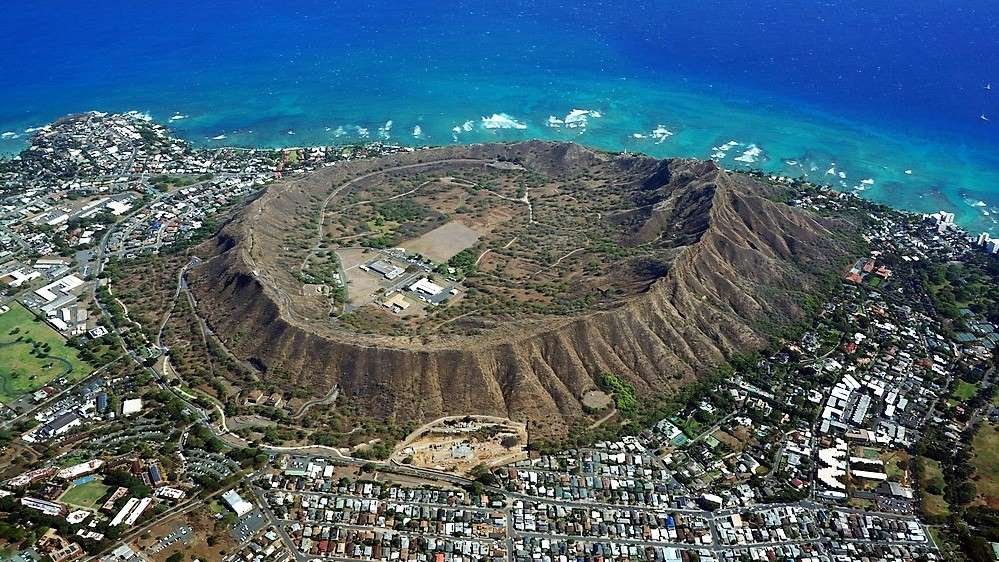Explore Diamond Head Crater: Hiking, History, Practical Info
Diamond Head is an iconic Hawaiian landmark, known for its circular hike and volcanic origins. Geologically and historically significant, this must-do hike offers panoramic views of Honolulu and beyond. In this article, we’ll explore Diamond Head’s history, formation, and environment, as well as provide practical information for visiting and hiking the crater.
Diamond Head History and Significance
Diamond Head, or “Leahi” in native Hawaiian, is recognized worldwide for its unique shape and prominence on the island of Oahu. Originally part of a coastal defense system, it contains bunkers and a navigational lighthouse. Additionally, the site was once home to a luakini heiau (temple) dedicated to the war god Ku. The dry terrain of Diamond Head is prone to erosion, making conservation efforts important.
Formation of Diamond Head
Created 300,000 years ago during a single eruption, Diamond Head is a tuff cone formed from ash and fine particles. The broad crater covers 350 acres, and its greater width than height sets it apart from other volcanic landmarks. A coral reef protects the seaward slopes of the crater, adding to its unique geological features.
Environment
The environment of Diamond Head is characterized by a semi-arid climate, shallow soil, and steep rocky slopes. Mostly low shrubs and herbs can be found here, with few native Hawaiian species remaining. A dryland forest once covered the crater, but most plants and animals were introduced after the 1800s.
Early History
Named by Hi‘iaka, the sister of fire goddess Pele, Diamond Head’s summit resembles the forehead of the ‘ahi fish. A heiau was built on the summit dedicated to the wind god, further adding to the area’s cultural significance. The Diamond Head Light, built in 1917, is a vital navigation aid for ships in the area.
Military History
Diamond Head’s strategic location made it an ideal site for coastal defense of O‘ahu. Fortification began in 1908 with gun emplacements, and the Fire Control Station Diamond Head directed artillery fire. Coastal defense was provided by long-range guns, ensuring the safety of the island during times of conflict.
Diamond Head State Monument

The Diamond Head State Monument is a dormant volcano crater on Oahu that is younger than the main mass of the Ko‘olau Mountain Range. British sailors named it Diamond Hill in 1825, and it later became home to Fort Ruger, the first US military reservation on Hawaii. Only Battery 407 and Birkhimer Tunnel remain in use today. A popular destination for tourists and residents of Waikiki, Diamond Head was declared a National Natural Landmark in 1968. The Diamond Head Lighthouse and pillboxes on the summit serve as reminders of its military past.
Diamond Head Crater Hike
The Diamond Head Crater Hike is a 1.6-mile trek that takes about 2 hours to complete. With a moderate difficulty level and 560 feet elevation gain, the hike starts on the west side of the crater and follows a rock pathway. Loose gravel on the trail requires proper shoes, and a lookout with ocean views provides a scenic resting point. Long, narrow stairs lead to a 22-ft tunnel, and the trail entry ends at 4 pm, with gates closing at 6 pm. No pets are allowed, except for service animals. Be sure to wear a hat, sunscreen, and bring water for this sunny adventure.
Practical Information
To visit Diamond Head, enter off Diamond Head Road. The trail is open from 6 am to 4 pm, and reservations are required for out-of-state visitors. There is a $5 per person reservation fee, but Hawaii residents can enter for free without reservations. Non-resident vehicles must pay a $10 entry fee, and only credit card payments are accepted. Comfortable walking or athletic shoes are recommended, as well as sunscreen, a hat, a light jacket, and snacks. Don’t forget to bring a charged cell phone and camera to capture the stunning views.
Visiting Diamond Head

The park is open daily from 6 am to 6 pm, with the best time to visit being the cooler early mornings. Spring and winter tend to be busy seasons. There are no military discounts available, and visitors without reservations will be turned away. Kama’aina may enter with a Hawaii ID, but their guests need reservations. Make sure to purchase an entry ticket for anyone entering the park.
Getting to Diamond Head
A 10-minute walk from the bus stop will bring you to Diamond Head. Parking is available for a fee ($10 for cars/vans, $20 for minibuses), but spaces are limited. You may need to park on Diamond Head Road and walk to the entrance.
Tips for Hiking Diamond Head
When hiking Diamond Head, remember to bring water, a hat, and sunscreen to protect yourself from the sun. Wear proper shoes and light clothing, and stay on designated trails to reduce erosion. Be prepared for uneven terrain and stairs, and take breaks as needed to enjoy the spectacular views. Lastly, bring a charged cell phone and camera to capture memories of your hike.

